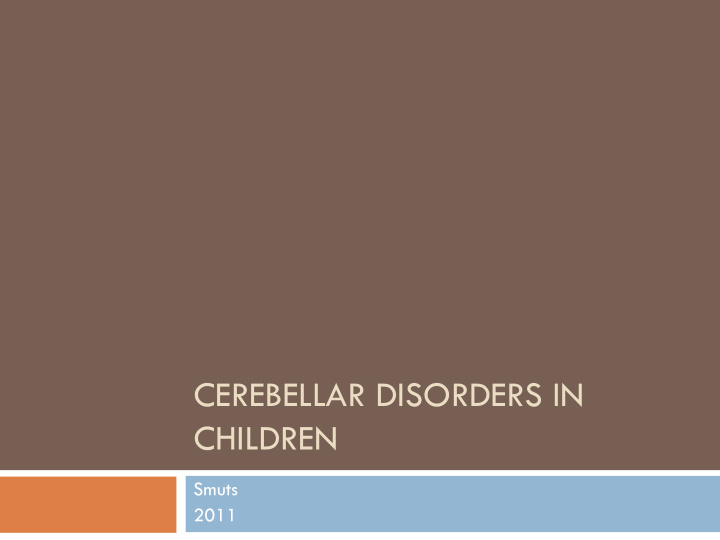



CEREBELLAR DISORDERS IN CHILDREN Smuts 2011
Movement Cerebellum Extra pyramidal system • Control of movement patterns • Control and execution of • Motor learning movements • Judge speed, force and direction • Includes: • Coordinator of information + • Basal ganglia • Receives information from • Thalamus • Muscle spindles • Subthalamic nuclei • Labyrinth, eyes, parietal cortex • Substantia nigra • Joints • Red nucleus • Pressure receptors • Brainstem reticular formation Fluent movement Start and stop of movement
Functional anatomical organization of the cerebellum Vestibulocerebellum Spinocerebellum Pontocerebellum
Functional anatomical organization of the cerebellum Vestibulocerebellum Adjustment of axial muscle tone Eye movements Coordination of the head and eyes Spinocerebellum Execution of movement Regulates muscle tone Pontocerebellum Precision in control of rapid limb movement
Cerebellar signs Non specific symptoms Headache Nausea Vomiting Gait difficulty Vertigo
Cerebellar signs Midline cerebellar disease Abnormal gait Abnormal posture of the head Ocular motor dysfunction Nystagmus Ocular dysmetria
Cerebellar signs Lateral cerebellar disease Hypotonia Dysarthria Limb ataxia Intention tremor Oculomotor disorder Opsoclonus Ocular bobbing
Ataxia - 3 broad categories Acute ataxia Chronic non-progressive Chronic progressive
Acute ataxia Sudden onset Can’t walk Extremely clumsy Can’t feed due to tremor Dysarthria Nystagmus unusual Look for signs of infections e.g. chickenpox History of possible intoxication If signs are symmetrical, no raised ICP , and no focal signs, usually benign
Acute ataxia: Aetiology Infections Posterior fossa tumour Cerebellar abscess Vascular Viral cerebellitis Haemorrhage Bacterial Embolism Metabolic: AVM Organic acidurias Pseudo-ataxia Leigh’s encephalopaties Hypoglycaemia Hyperammonaemia Toxins Alcohol Phenytoin Phenobarbitone, Lead Glue Vit A
Chronic non progressive ataxia Ataxic/Hypotonic CP Often a congenital malformation of the cerebellum
Aetiology: Chronic non-progressive ataxia Joubert syndrome Perinatal insults Birth asphyxia Cerebellar/ kidney Metabolic associations Intra ventricular Postnatal acquired haemorrhage Hypoxia Meningitis Hypoglycaemia Congenital Chronic phenytoin malformations Thiamine deficiency Primary cerebellar Trauma hypoplasia Hydrocephalus Foetal alcohol syndrome
Chronic progressive ataxia Lesion in cerebellum with loss of: Purkinje cells Cerebellar nuclei Afferent or efferent pathways Olivary atrophy Spinocerebellar degeneration Post column demyelination Peripheral nerve lesion
Ataxia telangiectasia Progressive ataxia(1-4 years) Abnormal eye movements - oculomotor apraxia Telangiectasia(3years-adolescence) Cutaneous manifestations High risk for malignancies Abnormality in cellular and humoral immunity Elevated alpha feto protein
Friedreich’s ataxia Onset before 20 years AR Progressive ataxia - gait difficulties, speech problems No nystagmus Weakness Positive Babinski but absent ankle and knee reflexes - involvement of the corticospinal tract Loss of position and vibration sense Positive Romberg test - involvement of the posterior columns Bladder dysfunction Involvement of cranial nerves Scoliosis Cardiomyopathy Diabetes mellitus
Recommend
More recommend